The Radical Club: a 1920s forum for ‘progressive cultural activity’
Published in Features, Issue 5 (September/October 2019), Volume 27A moment in modernism’s development in Ireland.
By Brian Trench
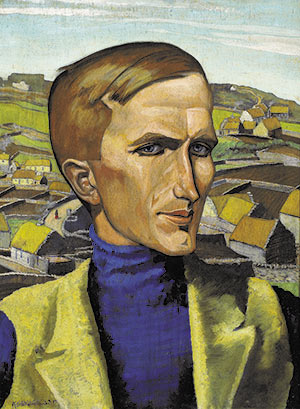
Above: Liam O’Flaherty—the main mover in setting up the Radical Club for ‘intellectual workers’ in 1925. (Estate of Harry Kernoff)
In April 1926 writers Liam O’Flaherty (front cover) and Francis MacManus debated the role of religion in Irish culture. O’Flaherty was ‘strongly anti-church’ while MacManus was ‘defending it’, according to one of those present, fellow writer Rosamond Jacob. All three were members of the Radical Club, which hosted this event as part of a series of talks and debates that ran through 1926.
Jacob’s detailed diaries, held in the National Library, and a few of O’Flaherty’s published letters are the only known sources of information on the club and its activities from direct participants. Jacob’s often cryptic notes include surprises, such as her remark that Professor Riddell, from England, attended the religion debate and ‘explained that outsiders thought Dublin the 2nd city for original culture in Europe’.
Even allowing for flattery of his hosts, the professor’s assessment would not chime at all with notions of post-Civil War Ireland as a dark, oppressive place in full counter-revolution. The establishment of the Radical Club inter alia to ‘fight for the freedom of cultural expression in Ireland’ indicates that such freedom was felt to be under threat but also that a place was sought for public discussion of progressive ideas.
Liam O’Flaherty and To-Morrow
Liam O’Flaherty was the main mover in setting up this forum for ‘intellectual workers’ in 1925. He brought to the venture his experience in left-wing politics and the status acquired from his literary breakthrough with the 1925 publication of The Informer. A First World War veteran and later world-travelling seaman, he had returned to Dublin in 1920 and wrote for socialist and republican periodicals.
In November 1921 he became a founding member of the Communist Party of Ireland, and two months later led a take-over of the Rotunda Concert Hall and Pillar Room by 200 of the unemployed. They held out there for four days before evacuating under threat of being forced out by the police. Moving to London, he submitted novels and stories for publication and caught the attention of Edward Garnett, who became a mentor and agent for the next decade. O’Flaherty had three novels published over the following three years. He also worked with Harry (later Francis) Stuart and artist Cecil Salkeld in setting up the cultural broadsheet To-Morrow in 1924, writing to Garnett, ‘I have gathered a group of faithful followers about me’.
Stuart and Salkeld signed an infamous editorial in the first issue that denounced the ‘rancid, coarse and vague’ style of the bishops’ pastorals, but also atheism and ‘the art and literature of modern Europe’. It has been repeatedly claimed that the real author of this editorial was W.B. Yeats, with whom Stuart was connected through his marriage to Iseult Gonne, daughter of Yeats’s muse Maud, but also as winner of a 1924 Aonach Tailteann poetry prize, presented by Yeats.
Among the contributions to that first edition of To-Morrow was a short story by O’Flaherty, the first part of a treatise on art theory by Salkeld and a poem by Yeats, whose domination of the literary scene O’Flaherty and his ‘faithful followers’ hoped to challenge. To-Morrow did not survive beyond its second edition but some of the same team were founding members of the Radical Club.
Radical Club adopted its constitution
In July 1925 O’Flaherty wrote to poet F.R. Higgins about the forthcoming first meeting of the new club, also mentioning ‘the Salkelds’ (Cecil and his mother Blanaid, a poet and playwright) as supporting the initiative. O’Flaherty canvassed his friend Seán O’Casey and the playwright attended the first meeting on 2 August 1925 but declined to get further involved in what he perceived as an anti-Yeats conspiracy.
The Radical Club adopted its constitution in October 1925, when F.R. Higgins was in place as the first chair. The club’s objects included: ‘to provide a centre of intercourse for Irish intellectual workers; to encourage all forms of progressive cultural activity in Ireland; to promote solidarity among artists, writers, scientists, and all people engaged in intellectual pursuits in Ireland’. For some months the club had three sections—literature, art and social. The literature section organised lectures and debates, while the social section ran cabarets that included revues, dancing and ‘saxophone music’. These were later run independently of the Radical Club as the Thalia, based in the art gallery, Egan’s Salon, on St Stephen’s Green, and later at addresses in Harcourt Street. The principal animator of these activities was the remarkable Madame Desirée (also Daisy and Toto) Bannard-Cogley, who a few years later became a founding director of the Gate Theatre and ran her own theatre for several decades.
By no means a unified platform
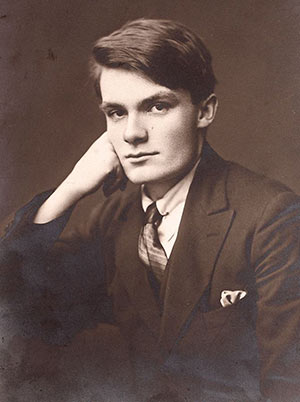
Above: Harry (later Francis) Stuart—one of the ‘group of faithful followers’ that Liam O’Flaherty gathered about him in 1924 when setting up the cultural broadsheet To-Morrow. The same team were founding members of the Radical Club.
Rosamond Jacob’s diaries give us a flavour of the personalities and polemics at the club, as well as an insight into the diversity of cultural and political activities— ceilidhs, lectures, Irish classes, art classes, demonstrations, radical journalism—in which she and friends took part at that time. The Radical Club was a forum for the discussion of new ideas in the arts and culture but by no means a unified platform for modernism. Francis MacManus gave a lecture to the club in January 1926 on ‘The Cult of the Abnormal in Literature’, denouncing Joyce’s Ulysses in terms that Jacob thought were ‘like the Catholic Bulletin talking’.
In February 1926 O’Flaherty and artist Patrick Tuohy took opposite sides in the controversy over O’Casey’s The Plough and the Stars, whose première had sparked ‘riots’ at the Abbey Theatre. O’Flaherty led the charge of the Radicals against his playwright friend, while Tuohy, an Easter Rising veteran and Citizen Army comrade of O’Casey’s, defended the play’s anti-heroic view of the Rising. Jacob notes that O’Flaherty spoke in the debate ‘with much more decent feeling than I’d expect—but didn’t give Tuohy a fair chance’.
In March 1926 ‘Harry Stuart read a short and interesting paper on modern poetry, which was torn to bits by [art student Seán] O’Sullivan (in a nasty rude humour) and others, but praised by some … [Stuart’s] way of reading poetry, an artificial intoning, is absolute torture’. A month after his clash with O’Sullivan, Stuart became president of the Radical Club, with O’Sullivan remaining on the committee. Stuart succeeded F.R. Higgins, who resigned in March 1926 with Brinsley MacNamara, according to Jacob, ‘because they feel the club is not acting up to its objects—too much energy gone into the cabarets, or not enough outside them. Mrs Cogley was offended and had to be flattered to be placated …’
Radical Club exhibition, May 1926
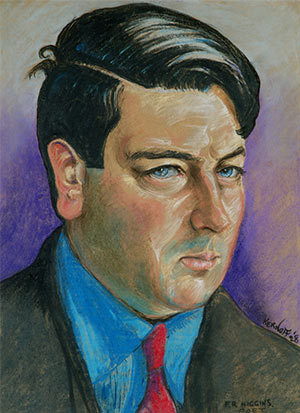
Above: ‘F.R. Higgins, poet’, by Harry Kernoff (1928). Higgins was the first chair of the Radical Club when it adopted its constitution in October 1925. (Crawford Art Gallery)
A highpoint of public visibility for the Radical Club was the staging of an exhibition in May 1926 by its Painters’ Group, of which Patrick Tuohy and his students at the Dublin Metropolitan School of Art (DMSA)—among them O’Sullivan and Maurice MacGonigal, who had been interned during the War of Independence—were the principal proponents. Tuohy’s senior colleague at DMSA, Seán Keating, was also supportive, and paintings of his were among the 120 works from a wide spread of artists in the exhibition at Egan’s Salon. Women artists were notably well represented, including the modernists Norah McGuinness, Nano Reid, Mainie Jellett and May Guinness.
Also there were leading Royal Hibernian Academy (RHA) members Jack B. Yeats, Oliver Sheppard and Albert Power, who showed simultaneously at the RHA annual exhibition and with the Radical Club. Harry Kernoff, a night student at DMSA, showed at the RHA in 1926 for the first time, as well as having eleven works (a tenth of the total!) with the Radicals. Through the club, Kernoff developed a strong personal and professional relationship with Bannard-Cogley, for whose productions he designed stage sets over many years. The unavoidable figure of W.B. Yeats appears here too, invited by the Radicals to open their exhibition. He took the opportunity to tell the young Radicals he did not care for the ‘extreme left’ in art, which he exemplified as ‘complete Cubism and Futurism’, but also that he could appreciate that ‘they treat art freely’ (Irish Independent, 4 May 1926).
The Radical Club exhibition was sympathetically reported in the Irish Times and Irish Independent, though a hostile review in the Irish Statesman (8 May 1926) described the show as containing ‘a quantity of tepid productions’. Reviewer Philip Deegan targeted Salkeld for his ‘disturbing, almost diuretic colours’. A sharp response (Irish Statesman, 15 May 1926) was signed for the Radical Club by DMSA students Patrick Trench, H.A. Kenney and Maurice MacGonigal, who claimed that Deegan ‘[came] to feed the spleens, the bitterness, the sense of defeat, which he has absorbed from Dublin like a sponge’.
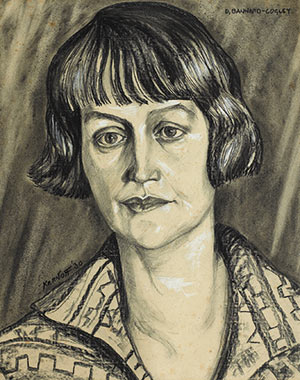
Above: Portrait of Madame Desirée (also Daisy and Toto) Bannard-Cogley by Harry Kernoff. She organised the Radical Club’s ‘social’ section and was later a founding director of the Gate Theatre. (Estate of Harry Kernoff)
Another DMSA student, Hilda van Stockum, still in her teens, had three paintings in the Radicals’ exhibition. Recalling that period 60 years later in two articles for the Irish Times (16 and 23 March 1985), she wrote fondly of Tuohy as a mentor who took her to dances and introduced her to the Radical Club and Arts Club. She remembered MacGonigal as ‘the senior student whom everyone looked up to’, fond of expounding his theories but also recounting stories of his imprisonment, and wrote that art students could go for free to Bannard-Cogley’s cabarets if they painted decorations. For this purpose van Stockum depicted O’Flaherty ‘with a bucket in each hand full of young ladies—he wasn’t too pleased with it’.
Decline
In June 1926 O’Flaherty withdrew from the Dublin scene to County Wicklow with Margaret Barrington, ex-wife of TCD history professor Edmund Curtis, living in ‘absolute seclusion’ and receiving only selected visitors, such as Constance Markiewicz and Captain White. Barrington had divorced Curtis and later that year married O’Flaherty; their daughter, Pegeen, was born some weeks later.
In October 1926 O’Flaherty wrote to Garnett that he and Barrington were back in Dublin and attending Mrs Cogley’s cabarets, which were ‘going strong’; Dublin was becoming ‘a lively place’ at that time. But when Rosamond Jacob attended a Radical Club dinner that month with Bannard-Cogley, her acting colleague Gearóid Ó Lochlainn, MacNamara, O’Flaherty and others, she found it ‘rather a dull affair—I can’t feel properly at home among that crowd’. The club committee elected that month comprised Stuart, Salkeld, O’Flaherty, MacManus, Jacob and artist Francis Bowe, as well as O’Higgins and Rossiter, whom I cannot further identify.
The committee discussed the possible publication of a monthly paper, which Jacob described as ‘pro secular control of education and anti-censorship of art … Very interesting’ but which did not materialise. Jacob was ‘regretting Tuohy from the Radical Club’ and was not impressed that there were ‘a lot of strangers’ and ‘few of the club’ at O’Flaherty’s lecture on imperialism on the eve of Armistice Day 1926. Whether as a sign of Jacob’s disaffection or of the club’s decline—most likely both—her diary entries on the Radical Club stop at the end of 1926, though in November 1927 she attended a ceilidh in Bannard-Cogley’s Little Theatre, ‘a lovely hall and floor, with frightful futurist heads decorating it, & also clever caricatures of Liam O’F, Mrs Cogley, Kernoff, P. Trench etc, etc’. Some of those Radical Club alumni pictured on the wall were also physically present.
Others expressed their radicalism in various ways: Harry Kernoff and Rosamond Jacob (and also Hanna Sheehy-Skeffington) were among those who in 1930 went to the Soviet Union with a trade union-based delegation of Irish Friends of Soviet Russia. O’Flaherty, no longer looking to be a leader, much less a follower, arranged an independent and extended visit, on which he socialised, drank and played with workers of many backgrounds and moved around without a guide, later writing a disillusioned account, I went to Russia.
In 1932 O’Flaherty broke with publisher Cape, agent Garnett and wife Barrington. By then he was a censored writer and he joined Yeats, Stuart and Higgins in setting up the Irish Academy of Letters to oppose censorship, which was formally institutionalised in 1929.
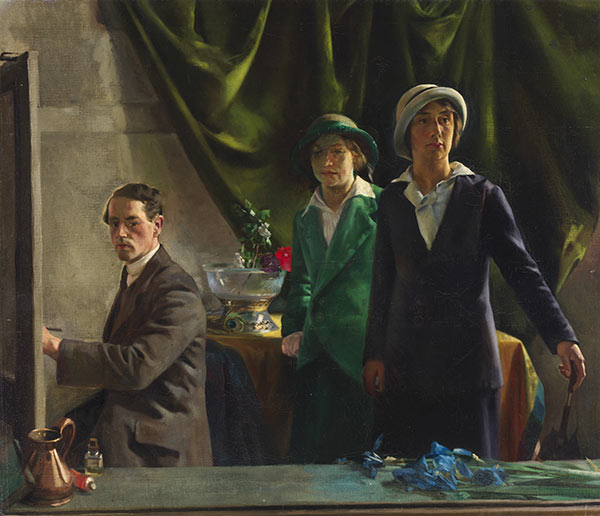
Above: Self-portrait of Patrick Tuohy with two lady friends. In a club meeting in February 1926 Tuohy defended O’Casey’s The Plough and the Stars against O’Flaherty’s criticism. (NGI)
Conclusion
The Radical Club is recalled briefly in cultural and art histories, in biographies of Keating and Kernoff, and in several entries on artists in the Dictionary of Irish Biography, though not in that on Liam O’Flaherty. In the absence of a full biography of O’Flaherty, that gap in the received accounts of the writer’s life remains to be filled. More strikingly, the Radical Club is not mentioned in Leann Lane’s biography of Rosamond Jacob, nor in the catalogue notes for the summer 2019 exhibition The Birth of Modernism, shown at Dublin Castle, which featured strongly the women artists mentioned earlier as well as many more who exhibited with the Radical Club. As a moment in modernism’s development in Ireland, an expression of the contradictions through which Ireland was living and a respite in the slide into social and cultural conservatism, the Radical Club may deserve to be remembered better.
Brian Trench is a researcher and editor, specialising in science communication, formerly at Dublin City University; he is a nephew of Patrick Trench (1905–48), mentioned in the article.
FURTHER READING
N. Allen, Modernism, Ireland and Civil War (Cambridge, 2009).
E. O’Connor, Seán Keating—art, politics and building the Irish nation (Dublin, 2013).
K. O’Connor, Harry Kernoff—the little genius (Dublin, 2013).
A. O’Kelly (ed.), The letters of Liam O’Flaherty (Dublin, 1996).
















